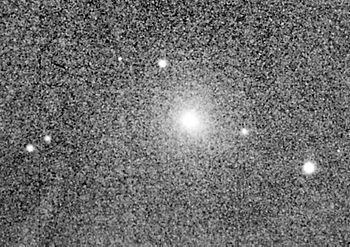26P / Grigg-Skjellerup
| 26P / Grigg-Skjellerup [i] | |
|---|---|

|
|
| Properties of the orbit ( animation ) | |
| Orbit type | short-term |
| Numerical eccentricity | 0.664 |
| Perihelion | 0.997 AU |
| Aphelion | 4.933 AU |
| Major semi-axis | 2.965 AU |
| Sidereal period | 5 a 38 d |
| Inclination of the orbit plane | 21.087 ° |
| Perihelion | March 23, 2008 |
| Orbital velocity in the perihelion | 38.48 km / s |
| history | |
| Explorer | J. Grigg , JF Skjellerup |
| Date of discovery | July 23, 1902 |
| Older name | 1902 II, 1922 I |
| Source: Unless otherwise stated, the data comes from JPL Small-Body Database Browser . Please also note the note on comet articles . | |
26P / Grigg-Skjellerup is a comet , of 1992 as the second goal of the Giotto probe of ESA was passed only 200 km away. Since the probe sustained camera damage when it encountered Halley , no recordings could be made.
The comet was named after the New Zealand teacher John Grigg and the Australian telegraph technician John Francis Skjellerup . Grigg first discovered the comet on July 23, 1902; Skjellerup rediscovered him in May 1922 from an observation site in South Africa.
Grigg-Skjellerup is the source of pi puppids - meteor shower , which on the southern hemisphere can be observed the Earth around 23 April. In 2003 a new mineral was discovered in this mineral which was named Brownleeit in honor of the astronomer and planetary researcher Donald E. Brownlee .